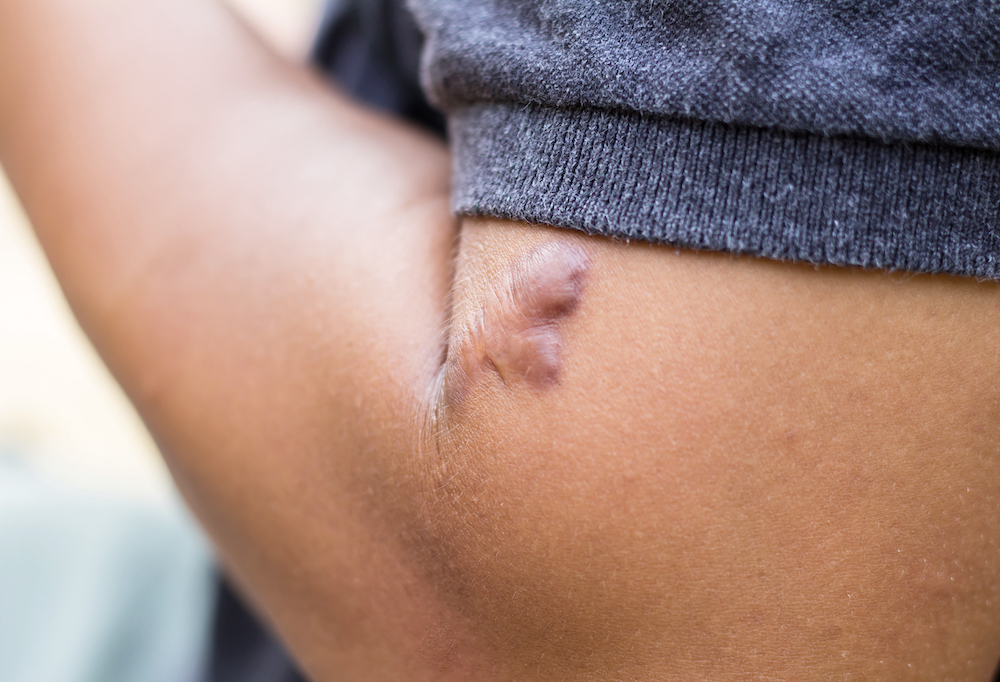3 Facts About Keloids

Keloids are very common but many people don’t know much about them. Often, people think that they just have a very unique scar when in fact, it is a keloid. A keloid is scar tissue that can appear after an injury to the skin. They can grow over time, becoming quite large and may even cause some itching and mild discomfort. People who have a keloid on a visible part of their skin may be self-conscious about it, and wonder what can be done to reduce its appearance or to prevent keloids from developing in the first place.
If you are wondering if a scar you have is actually a keloid, read on to learn more about the condition, including some facts that can help you identify if you have a keloid.
What is a Keloid?
When the skin sustains an injury, the body heals itself by developing scar tissue. Keloids are a type of scar tissue. However, they often develop quickly and grow larger than the original wound. It can continue to grow for months or even years. When a keloid appears at a joint such as an elbow or knee or covers a large surface of the body’s skin, it can even restrict movement and cause discomfort.
A keloid is typically brown or pink in color and feels rubbery to the touch. It will appear at the site of an injury such an incision after surgery, an acne blemish, pierced ears or any kind of damage to the skin.
Keloids generally appear in younger people who have experienced acne inflammation, an injury or surgery. However, keloids can occur at any age. Some people are genetically predisposed to developing keloids.
Quick Facts About Keloids
Keloids are commonly found…
Keloids can develop anywhere where injury has occurred to the skin. There are places on the body where keloids are more likely to develop. These locations include the earlobes, back, shoulders and chest. Many people who are prone to keloids can also develop them at the site of a pimple or other inflamed growth on the skin. A large percentage of people who develop a keloid do so after a piercing, especially one in their ears. For those who are prone to keloids, you should take care to avoid an injury to the skin that occurs at these common locations. You may also choose to avoid piercings anywhere on the body and especially on your ears.
Keloids are more common on skin of color.
While anyone can develop a keloid, there are some factors that can increase your chances of developing one. Keloids are more commonly found in people with darker skin tones. They also more frequently appear in younger people, often before the age of 30. Genetics can also be a significant factor.
How to Treat Keloids
A keloid is not dangerous in itself, but many people who have a keloid want to know what treatment options are available to them. Keloids can be itchy and uncomfortable. Depending on their location on the body, they can get in the way of movement. Larger keloids can be visually unappealing to the individual and even sustain injuries during sports or regular activity.
If you believe you have a keloid, the first thing you should do is contact a dermatologist near you. For those living in the Atlanta area, Dr. Straughn is one of the leading board-certified dermatologists treating skin of color and skin conditions including keloids.
When you schedule an appointment at either our Atlanta or College Park office, Dr. Straughn will evaluate your skin and provide you with an accurate diagnosis. After hearing about your skin and health history, she can work with you to develop a treatment plan to help you reduce your keloid to the highest degree possible.
Some of the most common treatment options for keloids include:
- Corticosteroid Injections
- Removal surgery
- Laser treatments
- Silicone sheets
- Cryotherapy
- Radiation
- Ligature
Keloid Treatment Atlanta Georgia
Do you live in the Atlanta area and have a keloid or other skin condition that you want to seek treatment for? Contact the office of Buckhead Dermatology today to schedule your appointment with Dr. Straughn and begin treatment of your keloids.
